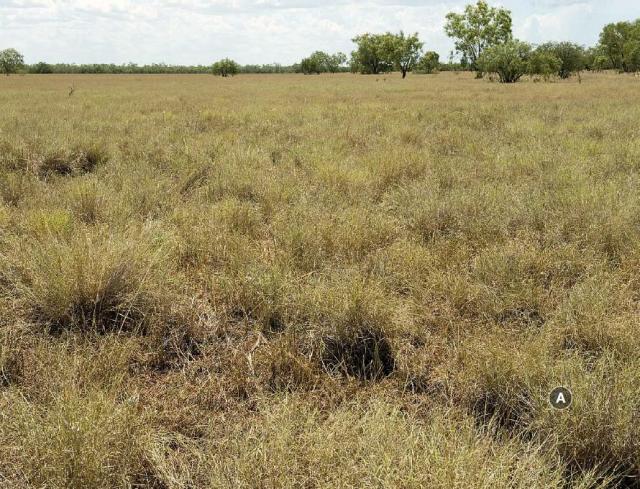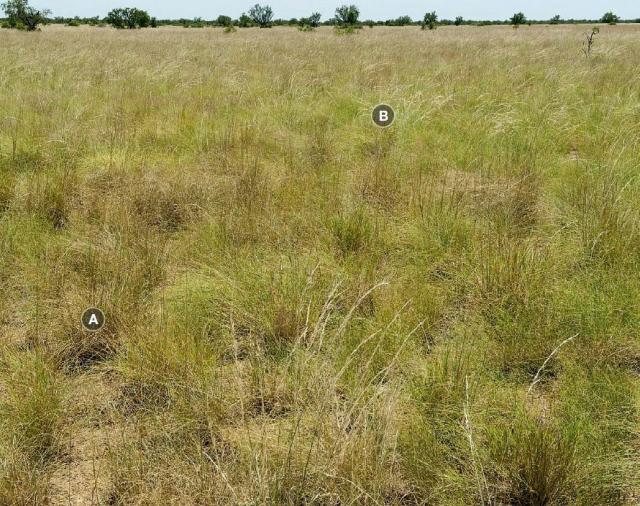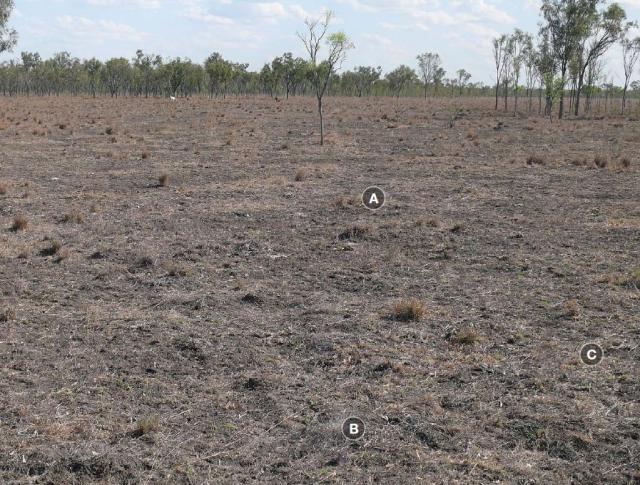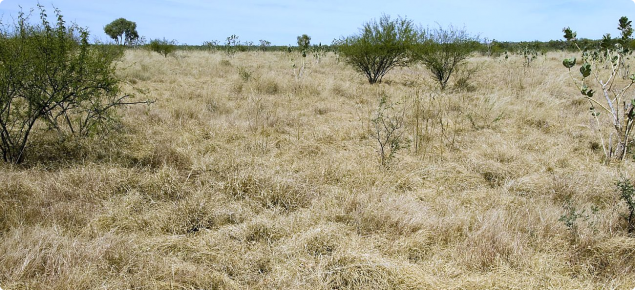Blue grass alluvial plain pastures
These pastures are part of the Kimberley 'black' soils group of pastures, and the perennial bundle-bundle and ribbon grasses are the identifier grasses. Use the interactive key to pasture condition to help identify pasture type.
Pastoral value
Blue grass pastures in good condition are highly productive and can be used with lower quality feeds to provide year-round grazing. DPIRD recommends wet-season and post-fire spelling. Overstocking may cause soil erosion which will have long-term and significant adverse impacts on pasture condition and pastoral productivity.
Forage value is adequate for growth during the wet season as bundle-bundle responds quickly to rain and can supply large quantities of good quality feed. During the dry season the palatability and quality of the forage declines and the pastures provide a sub-maintenance (around 4% protein) ration for stock.
This is the most productive pasture group in the north Kimberley as it provides good quality feed for six months of the year. Blue grass pastures are often burnt at the beginning of the dry season to remove rank growth and to provide nutritious green pick. These pastures should not be burnt every year as this will reduce plant vigour.
Blue grass Pastures on the alluvial plains provide nutritious feed well into the dry, but protein levels in those of the North Kimberley will decline faster because of the higher rainfall and humidity leaching nutrients from the soil and plants. Late in the dry season the quality declines to provide a sub-maintenance level of nutrition.
Management
Blue Grass pastures are of most use to stock when grazed over the dry season. Accessibility is often restricted over the wet season as the clay soils of this pasture type can get quite boggy. These pastures should be allowed to set seed by removing the cattle over the wet season. If burnt, then cattle should be removed until the plants have re-established. If cattle can’t be removed, burn large enough areas to prevent cattle overgrazing small patches. Overstocking may result in soil erosion which will have long-term and significant adverse impacts on pasture condition and pastoral productivity.
Blue grass pastures are highly productive and should be used in conjunction with lower quality pastures to provide year–round feed.
Blue grass pasture carrying capacity
| Condition | Hectares per cattle unit alluvial soil | Hectares per cattle unit basaltic soil |
|---|---|---|
| Good | 8 | 17 |
| Fair | 17 | 33 |
| Poor | 83 | 167 |
Distribution and soil type
Blue grass pastures are found on areas of black soil in the higher rainfall areas of the Kimberley. These are the major pastures of the Duffer, Isdell, Ivanhoe and Willeroo land systems, an important component on the Alexander, Cowendyne, Gladstone and Legune land systems, and a minor component on many other land systems. They are found on some of the floodplains of major rivers and in isolated pockets of black soil in basalt country of volcanic origin in the North Kimberley.
Vegetation structure and composition
Structure and composition are variable and a function of rainfall, soil type and position in the landscape. Pastures may be tussock grasslands with isolated to very scattered trees, with projected foliar cover (PFC) of up to 10%, on alluvial plains, or tussock grasslands with scattered trees (PFC 10-20%) on soils of basaltic origin. In each case, the grass layer is dominated or co-dominated by bundle-bundle (Dichanthium fecundum). Bundle-bundle is the common name of the perennial bluegrass found in the Kimberley region. On the alluvial plains, the co-dominant grass is ribbon grass (Chrysopogon fallax), while on the basaltic soils the co-dominant species is perennial sorghum (Sorghum plumosum).
On the alluvial black soil plains the most common trees are bauhinia (Bauhinia cunninghamii), corky bark wattle (Acacia suberosa) and whitewood (Atalaya hemiglauca). Conkerberry (Carissa lanceolata) is the most common shrub. While bundle-bundle may dominate the grass layer, other grasses include ribbon grass (Chrysopogon fallax), feathertop threeawn (Aristida latifolia), white grass (Sehima nervosum), wire grass (Eriachne obtusa), and silky browntop (Eulalia aurea).
On the basaltic plains in the north the trees include rosewood (Terminalia oblongata subsp. volucris), Darwin box (Eucalyptus tectifica), bloodwood (Corymbia dichromophloia) and ghost gum (C. bella). While bundle-bundle may dominate the grass layer, other grasses include ribbon grass, perennial sorghum, white grass, pan wanderrie grass (Eriachne glauca) and black speargrass (Heteropogon contortus). The proportion of perennial sorghum increases and the amount of ribbon grass declines as you go north.
Assessing pasture condition
The condition of these pastures is assessed by the degree of ground cover (% basal cover) of grass tussocks, the vigour of the tussocks, age structure of the stand, the proportion of undesirables in the stand, and the condition of the soil surface.
Blue grass pastures in good condition on the alluvial plain will be dominated by bundle-bundle or co-dominant with ribbon grass. Other grasses may include some native millet (Panicum decompositum) and some feathertop threeawn. On the basaltic soils blue grass pastures in good condition will be dominated by bundle-bundle, but perennial sorghum may be co-dominant. Other grasses will include ribbon grass and black speargrass, and white grass may be present. Basal cover may be 4 to 10% or more of the soil surface.
In fair condition on the alluvial plain the distance between butts of desirable grass will increase. Basal cover will decrease to 1 to 3%. The proportion of the intermediate grasses, such as wire grass and annual sorghum (Sorghum stipoideum), will increase to above one third of the stand. Undesirables such as feathertop threeawn will become a significant part of the stand. Shrubs such as mimosa bush (Acacia farnesiana) may form an increasing part of the stand.
Blue grass pastures in fair condition on the basaltic soil will have an increasing distance between butts of desirable grasses. The proportion of intermediate grasses, such as black speargrass, white grass, and pan wanderrie grass, will increase to be more than a third of the stand. Some bare ground will be evident and loss of soil may be evident.
Blue grass pastures in poor condition on alluvial soils and basaltic soils will have few desirable perennials; there will be much bare ground present and some erosion may be evident. On the alluvial soils undesirables such as feathertop threeawn may become a significant part of the stand.
Rangeland condition assessment (2000-2009) and long-term monitoring data (WARMS) indicated that blue grass pastures in the Kimberley were mostly in fair condition (around 55%), and approximately equal amounts of blue grass pastures in good and poor condition.
Pasture condition rating
Good: In good condition, blue grass pastures are dominated by bundle-bundle or co-dominated with ribbon grass or perennial sorghum (on basalt). Other grasses may include native millet and feathertop, and black speargrass is likely to be present on basalt. There is very little bare ground visible, unless the pasture is heavily grazed, and the plants appear vigorous.

Fair: Prolonged heavy grazing reduces the density of desirable species. Intermediate species are more prominent and may make up one-third or more of the stand. The lower density and smaller size of desirable plants allows undesirable species, such as feathertop, to increase. Shrubs, such as prickle bush, may also increase. Some bare ground will be evident and loss of soil may occur on basalt country.

Poor: Blue grass pastures in poor condition have few desirable species. Bare ground will be obvious, and erosion may be evident. Undesirable species, such as feathertop, may become a significant part of the stand.

Associated plants
| Common name (link to DPIRD species page) | Scientific name (link to FloraBase) | Life form |
|---|---|---|
| Desirable species | ||
| perennial grass | ||
| perennial grass | ||
| perennial grass | ||
| perennial grass | ||
| Intermediate species | ||
| perennial grass | ||
| Pan Wanderrie grass | perennial grass | |
| Wire grass, Northern Wanderrie grass | perennial grass | |
| perennial grass | ||
| perennial grass | ||
| Flemings bush | perennial herb or shrub | |
| Undesirable species | ||
| perennial grass | ||
| Prickle bush, mimosa bush | tree or shrub |


